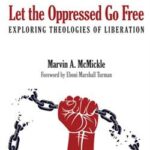
Bible on church pulpit, with light coming through the front doors.
Photo by emneemsphotos
Let the Oppressed Go Free: Exploring Theologies of Liberation (Book excerpt)
Christine A. Smith calls sexism in the church’s ongoing life “the stained glass ceiling”[i]—the invisible but often impenetrable limits imposed upon female clergy. The stained-glass ceiling takes many forms. Among the most common are differences in salary between men and women performing the same functions. It shows up in invitations to women to serve as one of several staff ministers with responsibility limited to a single area of church life, such as youth ministry, Bible study, or some outreach activities.
The stained-glass ceiling is most often shattered in one of two ways. Option one is to change denominations and serve a largely white congregation or serve a black congregation that belongs to a predominantly white national church body. Option two is to organize their own church and grow a congregation from the ground up. What has been and continues to be less available to women is the steady, upward mobility from a smaller to a larger congregation that is the normal career path for most male clergy.
Smith reflects on the limited opportunities for women in ministry when she states:
Contrary to some reports, female clergy have not yet arrived. While a few denominations such as United Methodists, the Presbyterian Church (USA), United Church of Christ, Disciples of Christ, and American Baptist Churches USA have accepted and called women to serve as senior pastors, many qualified and well-equipped sisters still struggle to have their gifts of preaching and pastoring recognized. Among those who have become senior pastors, remnants of the stained-glass ceiling persist.[ii]
What the Bible Says about Women
In Paul’s first-century Palestine, women were not considered independent citizens of the country. Their status was always in relation to some male family member, such as husband, brother, father, son, or uncle. Consider the feeding of the five thousand (Matthew 14:13-21). Jesus fed “about five thousand men, besides women and children.” Also, recall the touching scene on the cross where Jesus assigns care of his mother to the apostle John reflecting the status of women in first-century Palestine: “From that time on, this disciple took her into his home” (John 19:26-27). This was a continuation of the kinsman redeemer principle at work in the Book of Ruth, where Boaz took Ruth into his house after the death of her husband (Ruth 4:8-12). Ruth had no standing on her own in that society.
The Old Testament laws pointedly condemned the abuse or exploitation of women, orphans, and strangers because all such persons were without status, protection, and personal resources in the patriarchal world of ancient Israel (Deuteronomy 10:18; James 1:27). Jesus corrected a patriarchal reading of Scripture in John 8:3-4 when the teachers of the law brought a woman who was caught in adultery. They wanted her to be stoned in accordance with Mosaic law. The problem was that Mosaic law required the man and the woman both to be stoned (Leviticus 20:10). I imagine that when Jesus knelt to write something in the ground, what he wrote was a question to that self-righteous and bloodthirsty mob: “Where is the man who must have also been caught in that same act of adultery?”
Women had no role in any aspect of social, political, or religious life in ancient Israel. The Roman Catholic Church argues that women cannot be priests in the twenty-first-century church because no woman served as one of Jesus’ apostles. How could such a thing have been possible in first-century Israel? This is an absurd argument based upon a faulty first premise. Women could not have been disciples of Jesus because women were not at liberty to leave their homes and travel around the countryside. More importantly, they would not have been taken seriously when they attempted to speak in the name of Jesus.
One cannot quote 1 Corinthians 14 and 1 Timothy 2 without considering the cultural differences separating the first and twenty-first centuries. Today, women do not need a kinsman redeemer if their husband dies. In keeping with the story of Ruth, nobody hands over a shoe as a means of transferring property from one person to another. And with the use of the word “property” in Ruth 4:7, there is yet another indicator of the status of Ruth; she was property and not a person. By comparison, the US Constitution defined African American slaves as 3/5ths of a person for taxation and representation of white men. That 3/5ths designation and excluding all citizenship rights made black people in America into chattel or personal property. How can men who rebelled against being viewed as property in the eyes of white men so easily seek to use biblical texts that relegate women to that same status? This is bad exegesis.
What the Bible Says about Women in Ministry
At the center of the church’s resistance to women in leadership are two biblical passages from Paul, employed in the twenty-first century as though time stood still so far as women’s societal role is concerned. In 1 Corinthians 14:34-35, Paul states, “Women should remain silent in the churches. They are not allowed to speak.” In 1 Timothy 2:11-12, Paul says, “A woman should learn in quietness and full submission. I do not permit a woman to teach or have authority over a man; she must be silent.”
As Marilyn Parker Jeffries notes, the church today is hindered by what can only be called bad exegesis from people who use Scripture to maintain and preserve their privilege:
Out of the pulpits we have had poor exegesis. That has been the major barrier that has prevented women from assuming their rightful place in the kingdom. I had to wrestle when I heard God call me, because I’d never been taught it was right for women to preach. I experienced a dual wrestling match between the call to preach (which was mind-boggling in itself) and what that meant for me as a woman, something that I’d never seen before. That struggle precipitated the development of a panic disorder within me. I was a wreck.[iii]
Selective Use of Biblical Texts
This selective use of Scripture should not be an unfamiliar practice for any African American with enough awareness of the slave era to know that slaveowners and the preachers they allowed to address their slaves make expert use of selected and preferred biblical texts that reinforced the notion that God ordained slavery and that slaves should be content in their bondage and obedient to their masters. Howard Thurman tells the story from his childhood of reading the Bible to his grandmother, who had been a slave. He recalls that he was never allowed to read anything from Paul. When he asked her about that in later years, she said:
During the days of slavery, the master’s ministers would occasionally hold services for the slaves. Old man McGhee was so mean that he would not let a Negro minister preach to his slaves. Always the white minister used as his text something from Paul. At least three or four times a year he used as a text: “Slaves be obedient to them that are your masters . . . as unto Christ.” Then he would go on to show how it was God’s will that we were slaves and how, if we were good and happy slaves, God would bless us.[iv]
Do the men who cling to the eternal and unchanging status of women based upon two Pauline texts also cling to this Pauline text from Ephesians 6:5 or a similar text in Colossians 3:22 that says, “Slaves, obey your earthly masters in everything; and do it, not only when their eye is on you and to curry their favor, but with sincerity of heart and reverence for the Lord”? Do the black male preachers who use Paul to prohibit women in ministry also embrace 1 Peter 2:18, “Slaves, in reverent fear of God submit yourselves to your masters, not only to those who are god an considerate, but also to those who are harsh”? What about Romans 13, which says, “Let everyone be subject to the governing authorities, for there is no authority except that which God has established . . . Therefore, it is necessary to submit to the authorities, not only because of possible punishment but also as a matter of conscience”?
It is unimaginable that any black male preacher would want to defend the principle of slavery reinforced in these passages. How can the same Bible set free the captives from racism while maintaining others in the captivity of gender discrimination?
I say with both deep sadness and regret that when setting the captives free from racism and segregation, the African American church and clergy were on board. However, that same desire for liberation all but vanished when the issue turned to women in ministry. It was as if they wanted to slice away a portion of the words of Paul in Galatians 3:27-29, where he says, “You are all sons of God through faith in Jesus Christ, for all of you who were baptized into Christ have now clothed yourselves with Christ. There is neither Jew nor Greek, slave nor free, male or female, for you are all one in Christ Jesus. If you belong to Christ, then you are Abraham’s seed and heirs according to the promise.”
One of the things I have found most disturbing about the use of this text is the way some readers try to ignore, overlook, minimize, or rationalize away the reference to “neither male nor female.” In this passage, Paul directly aimed at the three major forms of social distinction in first-century Jewish culture: ethnicity, class, and gender. Paul argues that those distinctions might still hold firm in secular society, but they have no place within the church and among those who believe in Christ.
There is no way to be against racism and ethnic discrimination but remain in support of sexism and gender discrimination. The captivity from which women and men both need to be set free requires a liberating theology that affirms freedom and opportunity for men equally available to women. “So if the Son makes you free, you will be free indeed” (John 8:36).
 Excerpted from Let the Oppressed Go Free: Exploring Theologies of Liberation by Marvin A. McMickle. copyright © 2020 by Judson Press. Used by permission of Judson Press.
Excerpted from Let the Oppressed Go Free: Exploring Theologies of Liberation by Marvin A. McMickle. copyright © 2020 by Judson Press. Used by permission of Judson Press.The views expressed are those of the author and not necessarily those of American Baptist Home Mission Societies.



